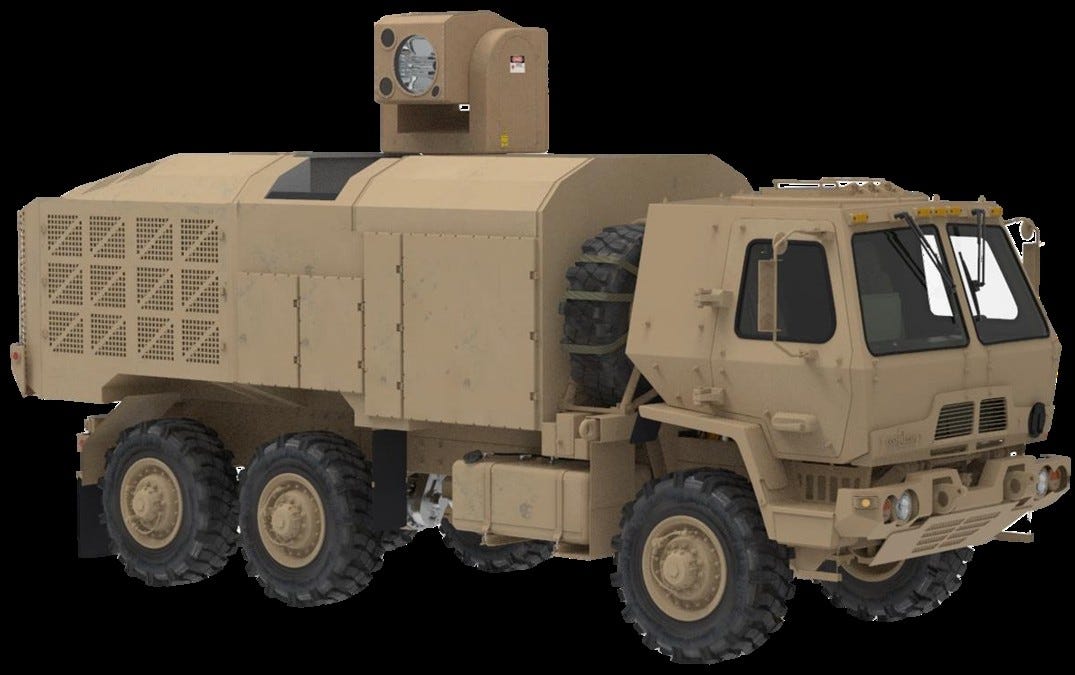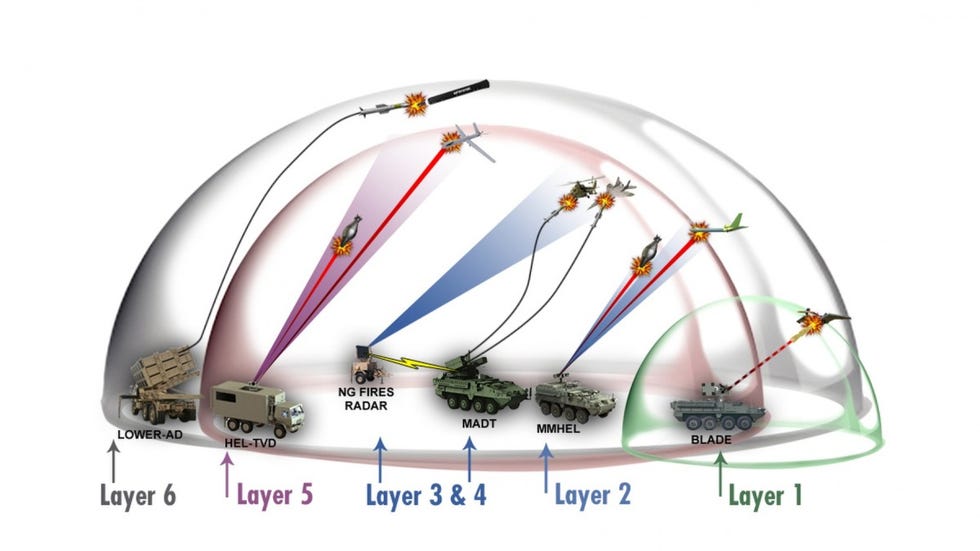SÉBASTIEN ROBLIN

The U.S. Army revealed last month that, back in January, it had deployed laser weapons for the first time to a war zone: a platoon of three Directed Energy or DE-Stryker armored vehicles detached from the 4th Battalion of the 60th Air Defense Artillery Regiment to help defend bases in the Middle East against constant drone, rocket, and mortar attacks from various Iranian-backed militias.

Wikimedia Commons
Platoon of the first four delivered DE M-SHORAD vehicles delivered to the 60th Air Defense Artillery regiment. These were redeployed for operational testing in the Middle East.
This news dropped at the same time as newly released plans explained that the Army was re-allocating human resources away from its special ops units. The intention is to instead stand up a larger force of short-range air defense with the goal of protecting soldiers from attacking drones, mortar rounds and cruise missiles. The urgency for such defenses was reinforced after an Iranian-designed kamikaze drone killed three U.S. soldiers in Jordan on January 27.
The Army’s short-range air defense (SHORAD) units—which the services is increasing to at least nine battalions—come in two flavors. Indirect Fire Protection Capability battalions protect static military bases and semi-permanent command posts using Stinger missiles and automated Land Phalanx gatling cannons. Divisional M-SHORAD battalions, on the other hand, defend frontline forces on the move using Avenger Humvee and Stryker vehicles also armed with Stingers.
But not only is the tried-and-true Stinger growing long in the tooth—it’s out of production. And a missile designed to shoot down manned aircraft costing millions of dollars is too expensive (over $120,000 for each refurbished expired missile) to cost-efficiently tackle drones costing just hundreds or thousands of dollars each, and which may be fielded in large numbers. Indeed, in Ukraine, both sides are expending over 10,000 kamikaze drones per month.
That’s why the Army doesn’t want to rely only on gun and missile-based defenses. Instead, it has several alternatives, like the laser-armed DE-Stryker and new drone-hunting Coyote Counter-UAS batteries equipped with interceptor drones.
The new drone threat
The affordable small civilian drones that rose to prominence in the early 2010s were rapidly weaponized and employed by insurgents in Iraq and Syria—a then novel, but not game-changing threat. But subsequent fighting in Ukraine has revealed that state actors could procure such low-cost quadcopters drones (and modestly more expensive fixed-wing military ones) in huge quantities and swiftly evolve them into surrogates for precision artillery, anti-tank missiles, and even long-distance strategic cruise missiles at a relatively cheap price.
Videos show reusable grenade-dropping drones and single-use kamikaze drones hunting down individual soldiers in trenches, devastating armored vehicles in the open, and even roaming around inside warehouses to kill vehicles concealed within.
This content is imported from x. You may be able to find the same content in another format, or you may be able to find more information, at their web site.
Larger drones costing in the tens of thousands of dollars have flown long distances to assail capital cities and remote airbases, occasionally destroying fighter jets, strategic bombers, and cargo planes on the ground worth tens of millions of dollars each. And such tallies don’t reflect what is possibly the most lethal use of drones: spotting targets for precision targeting by artillery, mortars, and tanks.
Ukraine’s drone warfare innovations were soon replicated by Russia, and it was clear that similar tactics could be effective against the U.S. military. Furthermore, the most commonly used types of drones in Ukraine were from China and Iran—unsurprising, as both emerged as major producers of lower-cost drones in the 2010s.
Bringing out the big (laser) guns
Lasers weapons have their upsides: precision, unparalleled speed, and limited risk of collateral damage. But they also have their downsides: very high energy requirements and reduced performance in obscuring weather.
But, crucially, lasers have a trivial cost per shot, which encourages their use against small, cheap drones. That matters when—as videos recorded in Ukraine have shown—the same vehicle or building is attacked in succession by many kamikaze drones (each costing just a few hundred dollars) to guarantee a kill.

Captain Todd Lopez, U.S. Army//Wikimedia Commons
Specialist Brandon Sallway, first ever tester of the Stryker-mounted MEHEL 5 kilowatt prototype laser in April 2017 pointing to marks indicating the 65 dronesheshot down during a trial at Fort Sill, Oklahoma, including both quadcopters and fixed-wing UAVs. Each shot from a laser tens of cents, compared over $120,000 for a Stinger missile, and $3 million for Patriot missile. Seven years later, DE-Strykers with a ten times more powerful 50-kilowatt lasers are being test deployed in the Middle East.
That’s the logic behind the Army’s eight-wheeled Stryker variant called DE M-SHORAD, which complements the service’s existing Stryker M-SHORADS armed with Stingers, Hellfire missiles, and 30-millimeter cannons. The laser-armed DE M-SHORADS might be tasked with defending brigade and divisional command posts.

Courtesy U.S. Army//Wikimedia Commons
A drone damaged by a truck-mounted High Energy Laser.
Currently, the service is testing a platoon of four Stryker A1s with a ‘Guardian’ turret by Raytheon/Kord Systems—one packing a 50 kilowatt laser sufficient for timely disabling of drones, helicopters, artillery rockets, and mortar rounds. Generally, laser-armed Strykers have performed excellently against drones, but encountered difficulties swatting faster artillery rockets and mortar bombs.
The Army also plans to test a buggy-style 4x4 Infantry Squad Vehicle armed with a 20-kilowatt laser for killing smaller Group 1 or 2-class drones.
Drone swarms a problem? Microwave’em!
Lasers may solve the cost-per-shot dilemma of blasting cheap drones, but defense analysts point out that they can only effectively engage one drone at a time. In future wars, however, drones enhanced with autonomous AI and mass-produce on an industrial scale may attack simultaneously in cooperative swarms of large numbers to overwhelm defenses with too many targets.
So, in 2023, the Army awarded $66 million to Epirus for the delivery of a platoon of four prototype high-powered microwave-weapons (HPMs) based on the company’s Leonidas counter-drone system. Leonidas uses a low-temperature gallium-nitride antenna combined with AI-enhanced smart power management system to project electromagnetic pulses that can affect a broad arc—a single pulse can disable multiple nearby drones. And despite the area of effect, Leonidas can also discriminate and exclude friendly systems from their pulses.
This content is imported from youTube. You may be able to find the same content in another format, or you may be able to find more information, at their web site.
Leonidas Counter-Electronics System – Generation 2
While electronic warfare can also have a broad area of effect against drones, it may be ineffective against drones with strong autonomous features that remove their dependency on satellite navigation and remote control signals. An EMP pulse doesn’t care about autonomy, as it’s directly disabling the drone’s electrical systems. Of course, that effect could also be potent against manned systems.
Offsetting those big advantages is Leonidas’s shorter range—a few hundred meters, which is much shorter than than the ranges of lasers—meaning its most effective against kamikaze or grenade-dropping drones that must get close to their targets, and less effective against surveillance or missile-armed drones. Thus, laser- and microwave-based defenses may complement rather than compete with each other.
The Army will test trailer-based HPM systems this year, though there’s also a pod for mounting on an 8x8 Stryker vehicle, which means the APC may be fielded in three different air defense variants.
This content is imported from youTube. You may be able to find the same content in another format, or you may be able to find more information, at their web site.
Beyond Stinger: towards new cruise missile defenses
Army IFPC battalions must also tackle one more threat that their mobile counterparts can’t handle: downing cruise missiles. While Stinger and Land Phalanx have some anti-cruise missile capability, neither is ideal, due to limited range.
Upgrading a laser to rapidly cause major physical damage requires a notable leap in output. That the Stryker’s 50-kilowatt weapon can burn drones out of the sky is notable, but the Army is also testing a ‘Valkyrie’ truck armed with a 300-kilowatt High Energy Laser powerful enough to burn through the skins of cruise missile before they reach their target. If testing this year is successful, the Army may procure Valkyrie in 2025 for its IFPC battalions. An even more powerful 500-kilowatt air defense laser is also being developed by the Army.

Courtesy U.S. Army//Wikimedia Commons
An HEL-TVD high energy laser demonstrator truck equipped with a 100 kilowatt laser. HEL-TVD served as a stepping stop between the original 10-kilowatt HEL-MD demonstrator truck and the new IFPC-HEL Valkyrie which has a 300-kilowatt laser able to destroy cruise missiles before they reach their target. A 500-kilowatt laser truck is also in development.
But the cruise missile threat is deadly and costly enough that it does also warrant the expenditure of counter-missiles. Back in 2019, Congress forced the Army to test-adopt two Israeli-designed Iron Dome batteries for cruise missile defense. But the Army was never enthused by them, and leased those systems back to Israel after the outbreak of war in Gaza last October. It’s now pursuing an “Increment 2” alternate solution based on the Enduring Shield launcher by Leidos/Dynetics, armed with heat-seeking Sidewinder missiles and seen as more capable against faster cruise missiles.
The service began receiving the first of 16 launchers in an Enduring Shield battery for testing in December of 2023—15 months behind schedule. Each launcher is truck-mountable, and holds up to eighteen heat-seeking AIM-9X Sidewinders (though only 60 Sidewinders are being delivered for testing). It’s also compatible with laser-guided AGM-114L Hellfire missiles and (possibly) Iron Dome’s low-cost Tamir interceptor missile.
If the Army’s plans come to fruition, these launchers may deploy alongside new sensor and guidance systems: Leidos’s secrecy-veiled ALPS 360-degree passive persistent surveillance sensor, Lockheed’s RIG-360 remote guidance datalink, and improved Sentinel AN/MPQ-64A4 radars (one for every four-launcher platoon). The Sentinel A4 features a new jam-resistant gallium-nitride AESA antenna with greater resolution, new capability to detect and determine the origin point of mortar and rocket artillery attacks, and a 75% range boost.
At the same time, the Army has allocated $204 million in 2025 for Raytheon and Lockheed to develop proposed successors to the Stinger missile for M-SHORAD units called the Next-Generation Short Range Interceptor, with a production decision scheduled by 2027. The Army specifies that NGSRI should remain compatible with existing Stinger launchers while flying faster to target, being more resilient against countermeasures, and remaining effective against drones with low heat signatures.
Under the same budget heading, the Army is funding the development of proximity air-bursting XM1223 multi-purpose shells to enhance the lethality of the 30-millimeter guns on air defense Strykers.

U.S. Army/Public Domain//Wikimedia Commons
Diagram of Army plans for integrated air defense circa 2019. Now Layer 6 will use the Enduring Shield launcher, Layer 5 the 300-kilowaat Valkyrie laser truck, Layer 3&4 the M-SHORAD Stryker and Layer 2 the DE-Stryker. It doesn’t seem look like the Army ended up committing to the Layer 1 system, however.
The diversity of new systems being developed and fielded reflects the breadth of air defense threats posed by drones and cruise missiles, which may approach at speeds ranging from 60 to 4,000 miles per hour and at altitudes ranging from near ground level to tens of thousands of feet high. While the optimal mix of systems is being determined, effective integrated air defenses (IADS) are multi-layered and incorporate diverse defeat mechanisms so that no single counter-counter-measure on an incoming drone or missile guarantees success.
No comments:
Post a Comment